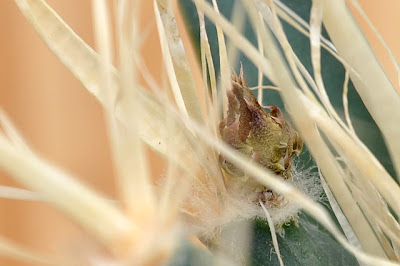I'm growing a few Leuchtenbergia principis plants (also known as agave cactus or prism cactus) in my cold house and have become quite fond of this atypical cactus with its greatly elongated gray-green tubercles and papery spines. Only one of my plants is old enough to flower and has attempted to do so for the last couple of years, but unfortunately the buds wither and die before the blooms unfold so I have yet to see a flower.
Withered Leuchtenbergia principis flower bud
Allegedly this species should be relatively easy to flower. In his book The Cactus Family Edward F. Anderson says “Leuchtenbergia is popular in cultivation, for it flowers freely during the day throughout late spring and summer and is quite hardy.” And according to the CSSA website L. principis plants “do not require any unique attention.”
Leuchtenbergia principis with dud flower buds
As mentioned above I grow the L. principis in my cold house but I brought the budding plant indoors not to miss the flower. I suspect this abrupt change in growing environment provoked the plant to stop developing its flower buds. I haven't seen the same behavior in any other species, but my Leuchtenbergia plant followed exactly the same pattern last year. Next time it develops flower buds I'll leave the plant in the cold house – even if it means that I'm going to miss the flowers (the cold house is located at my summerhouse, so I don't frequent it on a daily basis ;-)
Leuchtenbergia is a monotypic (having only one species) genus that is found in limestone soil throughout the Chihuahuan Desert of northern and central Mexico in Coahuila, San Luis Potosi, Guanajuato, Zacatecas and Hidalgo. According to Anderson Leuchtenbergia principis almost always grow in or beside a clump of Agave lechuguilla or a rosette-forming yucca in habitat and are nearly invisible except when flowering.
Malpighia 1927 v.30 (added: 11/24/2025)
-
*By:*
Borzi, Antonino,1852-1921.
Penzig, O.1856-1929.
Pirotta, Romualdo,1853-1936.
*Publication Info:*
Messina : g. Capra & co., 1887-89 ; Genova : Tip. di A...
1 month ago



















About a month ago, one my Leuchtenbergias showed signs of imminent bud development; but then some days later, I found nothing over there! I think the same could happen, but I'm not sure, because it was impossible for me to go to the roof of my house, where I keep my plants, to keep an eye on the Leuchtenbergia, because that week rained like the end of times here in Mexico City.
ReplyDeleteMany parts of the city flooded, and unfortunately some of my plants died. Among them there were a Denmoza rhodacantha, two M. dixanthocentron, one M. rhodantha var. pringlei and a Pseudolithos dodsoniana. :(
I'm sorry to hear about your plant losses - the heavy rains flooding Mexico City also made it to the news here in Denmark, showing footage of streets virtually turned into rivers. I can imagine it would be a challenge for many cacti to cope with that kind of weather.
ReplyDeleteI guess we can't accuse your Leuchtenbergia of being difficult for dropping it flower buds when exposed to massive torrents of water like that ;-)
I really like posts like this! :)
ReplyDeleteIt's about JUST cacti! GREAT PICS!!!
I want to see more of this!!!
I read somewhere that Leuchtenbergia needs A LOT of water when it comes to flowers or the buds will abort. Probably not as much water as a torrential rain, but still more than usual. Could that be the problem?
ReplyDeleteZ, that might very well explain why the buds aborted. I watered the plant thoroughly a couple of weeks before noticing the buds and it haven't received much water since (I hold back on the water at this time of year as the plant has to winter in a cold house). Next year I'll try to water the plant more often, starting earlier in the season, to see if it will induce buds and ensure that they actually develop into flowers.
ReplyDeleteI found this while surfing around:
ReplyDeletehttp://blossfeldiana.com/2009/05/16/a-broken-leuchtenbergia/
z, thanks for sharing this link. I'll have to experiment with supplying my Leuchtenbergia principis with more water and see if that encourages them to flower beautifully, as the post says.
ReplyDelete